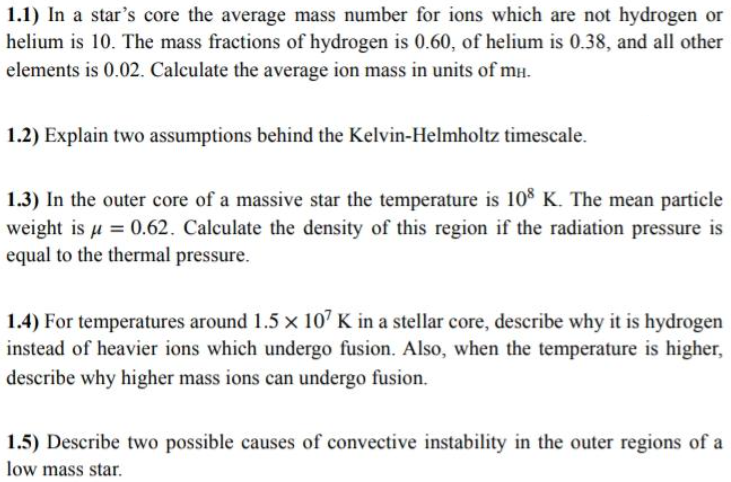1.1) In a star's core the average mass number for ions which are not hydrogen or helium is 10. The mass fractions of hydrogen is 0.60, of helium is 0.38, and all other elements is 0.02. Calculate the average ion mass in units of mH. 1.2) Explain two assumptions behind the Kelvin-Helmholtz timescale. 1.3) In the outer core of a massive star the temperature is 108 K. The mean particle weight is u = 0.62. Calculate the density of this region if the radiation pressure is equal to the thermal pressure. 1.4) For temperatures around 1.5 x 10' K in a stellar core, describe why it is hydrogen instead of heavier ions which undergo fusion. Also, when the temperature is higher, describe why higher mass ions can undergo fusion. 1.5) Describe two possible causes of convective instability in the outer regions of a low mass star.
1.1) In a star's core the average mass number for ions which are not hydrogen or helium is 10. The mass fractions of hydrogen is 0.60, of helium is 0.38, and all other elements is 0.02. Calculate the average ion mass in units of mH. 1.2) Explain two assumptions behind the Kelvin-Helmholtz timescale. 1.3) In the outer core of a massive star the temperature is 108 K. The mean particle weight is u = 0.62. Calculate the density of this region if the radiation pressure is equal to the thermal pressure. 1.4) For temperatures around 1.5 x 10' K in a stellar core, describe why it is hydrogen instead of heavier ions which undergo fusion. Also, when the temperature is higher, describe why higher mass ions can undergo fusion. 1.5) Describe two possible causes of convective instability in the outer regions of a low mass star.
College Physics
10th Edition
ISBN:9781285737027
Author:Raymond A. Serway, Chris Vuille
Publisher:Raymond A. Serway, Chris Vuille
Chapter12: The Laws Of Thermodynamics
Section: Chapter Questions
Problem 28P: Suppose the Universe is considered to be an ideal gas of hydrogen atoms expanding adiabatically. (a)...
Related questions
Question

Transcribed Image Text:1.1) In a star's core the average mass number for ions which are not hydrogen or
helium is 10. The mass fractions of hydrogen is 0.60, of helium is 0.38, and all other
elements is 0.02. Calculate the average ion mass in units of mH.
1.2) Explain two assumptions behind the Kelvin-Helmholtz timescale.
1.3) In the outer core of a massive star the temperature is 108 K. The mean particle
weight is u = 0.62. Calculate the density of this region if the radiation pressure is
equal to the thermal pressure.
1.4) For temperatures around 1.5 x 10' K in a stellar core, describe why it is hydrogen
instead of heavier ions which undergo fusion. Also, when the temperature is higher,
describe why higher mass ions can undergo fusion.
1.5) Describe two possible causes of convective instability in the outer regions of a
low mass star.
Expert Solution
This question has been solved!
Explore an expertly crafted, step-by-step solution for a thorough understanding of key concepts.
Step by step
Solved in 3 steps

Recommended textbooks for you

College Physics
Physics
ISBN:
9781285737027
Author:
Raymond A. Serway, Chris Vuille
Publisher:
Cengage Learning

Astronomy
Physics
ISBN:
9781938168284
Author:
Andrew Fraknoi; David Morrison; Sidney C. Wolff
Publisher:
OpenStax

Horizons: Exploring the Universe (MindTap Course …
Physics
ISBN:
9781305960961
Author:
Michael A. Seeds, Dana Backman
Publisher:
Cengage Learning

College Physics
Physics
ISBN:
9781285737027
Author:
Raymond A. Serway, Chris Vuille
Publisher:
Cengage Learning

Astronomy
Physics
ISBN:
9781938168284
Author:
Andrew Fraknoi; David Morrison; Sidney C. Wolff
Publisher:
OpenStax

Horizons: Exploring the Universe (MindTap Course …
Physics
ISBN:
9781305960961
Author:
Michael A. Seeds, Dana Backman
Publisher:
Cengage Learning

An Introduction to Physical Science
Physics
ISBN:
9781305079137
Author:
James Shipman, Jerry D. Wilson, Charles A. Higgins, Omar Torres
Publisher:
Cengage Learning

Stars and Galaxies (MindTap Course List)
Physics
ISBN:
9781337399944
Author:
Michael A. Seeds
Publisher:
Cengage Learning

Foundations of Astronomy (MindTap Course List)
Physics
ISBN:
9781337399920
Author:
Michael A. Seeds, Dana Backman
Publisher:
Cengage Learning